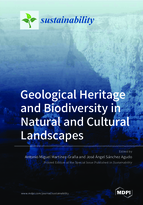Geological Heritage and Biodiversity in Natural and Cultural Landscapes
A special issue of Sustainability (ISSN 2071-1050). This special issue belongs to the section "Sustainability, Biodiversity and Conservation".
Deadline for manuscript submissions: closed (25 January 2021) | Viewed by 30500
Special Issue Editors
Interests: applied geomorphology; remote sensing and GIS; environmental geology; geomorphology and geological risk
Special Issues, Collections and Topics in MDPI journals
Interests: Conservation biology; Biological Heritage and Biodiversity; Landscape degradation: climate change, agrecosystems, ethnobotany
Special Issue Information
Dear Colleagues,
Geological Heritage has very diverse elements, both for its intrinsic nature and for its social and scientific significance. These elements have a scientific dimension (stratigraphic, geomorphological, lithological, paleontological, etc.) and a landscape dimension, both with implications for territorial management. In territorial management and planning, it is essential to carry out an inventory and cataloging of places of natural and social interest, to establish a comprehensive policy. The identification and valuation of the geological and biological heritage, and their interaction in the landscape, should favor the conservation and preservation of this natural and historical heritage. Sustainable development implies a rational use that prevents the degradation or loss of these unique environments of the natural environment; as well as a dissemination and awareness of landscape resources, for a better understanding and enjoyment, integrating activities of environmental education and nature tourism.
The diversity of a territory is the result of the complex and continuous interaction of the geological substrate (geotopical) and biological factors that model the existing ecological and evolutionary processes at the level of genes, species, ecosystems, and landscapes, and that are expressed in a characteristic representation of organisms adapted to these factors. These vary according to the spatial dimensions and the temporal scales considered, in a wide range that goes from the geological processes that involve millions of years and vast territories to the casuistic biotic and anthropic events that can occur in an instant in any territorial sector.
However, it is the circumstances derived from human activity that in recent decades are intensely modeling natural landscapes on a planetary scale. Whether this process of global “domestication” is part of the natural evolutionary cycle or not is an issue that is subject to intense debate and is inextricably associated with the other crucial debate on the ethics of human development. Is it incompatible with the preservation of geodiversity and biodiversity and landscape agreements? Is it possible to obtain the necessary resources from a territory without draining them and maintaining the ecosystem services of the same? Is there a more responsible social and political paradigm with the preservation of the natural environment? From the point of view of science, one of the ways to contribute objectively to that evaluation is to provide the collection and processing of field and laboratory data, which determine and model trends to explain this diversity and the geo-environmental interactions present in each rural and/or natural landscape, including the human species. The objective of this Special Issue is to highlight the importance of studies on geological and biological heritage and their involvement in geodiversity and biodiversity in an integrated way in the landscape, describing varied methodologies applied to specific territories (cultural and traditional heritage,) taking into account the singularity and its geoconservation based on active processes (geological risks, anthropic environmental impacts, etc.) and dynamics of its ecosystems (biological invasions, bioindicators, ethnobotanical studies, interactions between species, agrobiodiversity, etc.). This Special Issue will collect high-quality papers that contribute to the methodology and application of both design approaches and evaluation and decision-making frameworks in the context of the definition of strategies for natural heritage (geological and biological) and landscape.
Dr. Antonio Martinez Graña
Dr. José Ángel Sánchez Agudo
Guest Editors
Manuscript Submission Information
Manuscripts should be submitted online at www.mdpi.com by registering and logging in to this website. Once you are registered, click here to go to the submission form. Manuscripts can be submitted until the deadline. All submissions that pass pre-check are peer-reviewed. Accepted papers will be published continuously in the journal (as soon as accepted) and will be listed together on the special issue website. Research articles, review articles as well as short communications are invited. For planned papers, a title and short abstract (about 100 words) can be sent to the Editorial Office for announcement on this website.
Submitted manuscripts should not have been published previously, nor be under consideration for publication elsewhere (except conference proceedings papers). All manuscripts are thoroughly refereed through a single-blind peer-review process. A guide for authors and other relevant information for submission of manuscripts is available on the Instructions for Authors page. Sustainability is an international peer-reviewed open access semimonthly journal published by MDPI.
Please visit the Instructions for Authors page before submitting a manuscript. The Article Processing Charge (APC) for publication in this open access journal is 2400 CHF (Swiss Francs). Submitted papers should be well formatted and use good English. Authors may use MDPI's English editing service prior to publication or during author revisions.
Keywords
- geological heritage and geodiversity
- biological heritage and biodiversity
- landscape: quality and landscape fragility
- cultural heritage and sustainability
- landscape degradation: climate change, agroecosystems, ethnobotany







